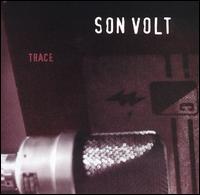
|
I asked the record store clerk what
was playing, the fall of 1995. She answered with a mumble. "Some
Dolt?" "Sun Bowl?" What was she saying, I wondered? I looked
confused, so she repeated the name, this time pointing to the cover. Son Volt's
debut, Trace, sounded
familiar even if the band was new to me. It seems that I had heard that singer
before. I vaguely recalled that after Uncle Tupelo fell apart, both of the
singer-songwriters were forming bands. Jay Farrar was recording his own
album.
So, this was it. "I like
it," I told the clerk. She shrugged. "Me too, but his voice gets to
me after too long." Farrar's former partner, Jeff Tweedy, brought the
sunnier side to their pioneering alt-country-punk blend. He played McCartney to
his co-singer and bassist's Lennon. No surprise that Tweedy's new lineup,
Wilco, continued the mix of rock but with lighter tunes, along with Americana
and, later, electronics. Son Volt, its name combining two historic studios,
hearkens back. It roams up and down alongside the Mississippi River, near Uncle
Tupelo's hometown of Belleville, Illinois. It may be a looser version of a
concept album, loneliness on a muddy bank.
Its forty-two minutes alternate rock
crunch with honky-tonk swagger, and feature desolate ballads followed by
slamming power chords. It's starkly produced by the same producer who worked with
Tweedy and Farrar before and after their new band's debuts, Brian Paulson.
Similarities endure. Unsurprisingly, Trace
continues where Uncle Tupelo's last album, Anodyne, left off. But it lacks evidence that Farrar had
progressed or dared more. This commitment, over Sun Volt's career, Farrar's
solo albums, remains the strength and weakness of Son Volt. I prefer them to
Wilco, but I remain in the minority, given Wilco’s great success since.
"May the wind take your
troubles away," Farrar sings as the album opens with "Windfall."
It is lovely, thanks to Dave Boquist's fiddle, but it risks right away exposing
the heart of Farrar's approach. Coming
out of his teens singing with Uncle Tupelo, he already sounded jaded,
world-weary, and about to fall into the grave after endless heartache and
repeated resignation. Are such lyrics a sign of a young talent adept at
channeling traditional tropes? Or, as Robert Christgau, who never liked Uncle
Tupelo either, sniped in a take-down of Trace,
a sign of stagnation?
These tracks compliment night rides,
gloomy mornings, lazy afternoons. For all their amplified attitude, bolstered
as on "Live Free," "Route" or "Drown" by original
Tupelo drummer Mike Heidorn, many of the brasher tunes don't leap out as much
as they should. Yet, "Tear Stained Eye" steps forward gracefully.
Farrar laments: "St. Genevieve can hold back the water/ Saints don't
bother with the tear-stained eye." It chugs along steadily, between a
banjo and pedal-steel backing. It deserves to be covered by many a bar-band
ever since. Similarly, "Ten Second News" crawls along appealingly, if
full of despair. "Catching On" sounds most like Tupelo, and balances
emotion with verve the best. Jim Boquist’s bass moves this along
forcefully.
"Too Early" adroitly adds accordion
to the mid-tempo arrangement. A concluding cover of Ron Wood's "Mystifies
Me" recalls a Rolling Stones' outtake from their early-1970s country-blues
period. With tracks laid down in the early winter of late 1994, this may
reflect Farrar’s confusion after his alliance with his longtime friend Tweedy
splintered. At least Heidorn had returned.
In closing, this album holds up
respectably. Son Volt's next two albums pursued this same style if to
diminishing returns. I had to stop my wife from throwing out that pair of CD's,
as she admitted boredom. Perhaps not by accident, Farrar then abandoned the Son
Volt name by the end of the 1990s for even less inspired solo records. He then
tellingly revived the more reliable band name in 2005. That ensemble issues
decent albums. Their latest, titled Honky Tonk, pays tribute to the C&W
Bakersfield sound. But it often feels indistinguishable from its inspirations
from decades earlier. Whether this is progress or complacency, I continue to
admire Farrar's voice. Yet, I find myself, like that record store clerk two
decades ago, tired of such dogged consistency.
I still wait for Farrar to take more
chances, as Uncle Tupelo, and punks, did. And, as a canny Wilco led by Tweedy
has done since 1995, to critical and popular acclaim. I'm not expecting Farrar
or the reconstituted Son Volt to play stadiums, or jam-band festivals. There's
a place for their more stolid, starker, roots-oriented music that challenges
complacency and unsettles listeners. But when I play my hometown L.A. heroes
such as X, The Gun Club, The Blasters, and Los Lobos, I hear how punk and
Americana joined forces to innovate. I think Uncle Tupelo blew doors open.
Wilco sauntered forward. Farrar and Son Volt snuck in that barn door behind. (Published 3/15: Holy Hell! Spectrum Culture series of looking back at albums 20 years earlier.)
|
||||||



















No comments:
Post a Comment